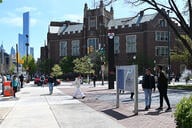You have /5 articles left.
Sign up for a free account or log in.
Nearly 60 percent of college students in New Mexico experienced food insecurity in the 2022–23 academic year, while 62 percent were housing insecure, according to a statewide study that included nearly all of the state’s institutions of higher education.
More than 13,500 students, faculty and staff responded to the first-ever statewide survey of basic needs insecurity. A separate report on the responses from faculty and staff is in the works. The University of New Mexico’s Basic Needs Project conducted the survey, which was funded by the New Mexico higher education department.
Of the 58 percent of students who experienced food insecurity, 39 percent were in the most severe category, meaning that their eating patterns were disrupted or they cut back on food intake because of a lack of money or other resources. Rates of food insecurity were much higher at tribal colleges, with 66 percent of students reporting they had very low food security, though more than half of students at two- and four-year colleges were also food insecure.
“The basic needs data points to a crisis in higher education that cannot be ignored, and collectively the State of New Mexico and higher education institutions are already beginning to face the reality that obstacles to retention [or] graduation may look differently than imagined: too many skipped meals, unplanned car repairs, living in a car, or not being able to get needed healthcare,” the report states.
The report’s authors recommended creating an office for basic needs at every New Mexico college and university, funding emergency grants to directly support students and increasing outreach to students to connect them with federal benefits. The state’s colleges and universities formed the New Mexico Basic Needs Consortium in spring 2023 to improve food security among students.
“Addressing this level of need will take a constellation of policies, coordination of efforts, and a dedication to serving students, families, and communities throughout the state,” the report’s authors wrote.




